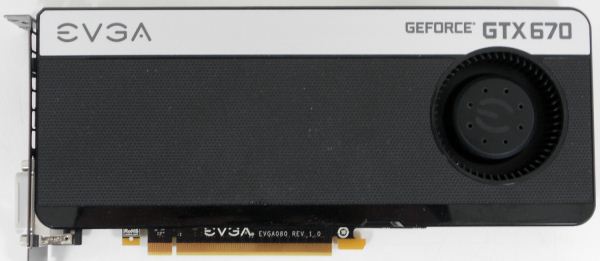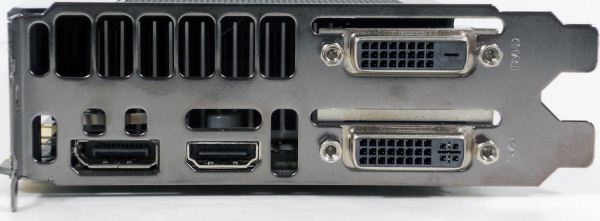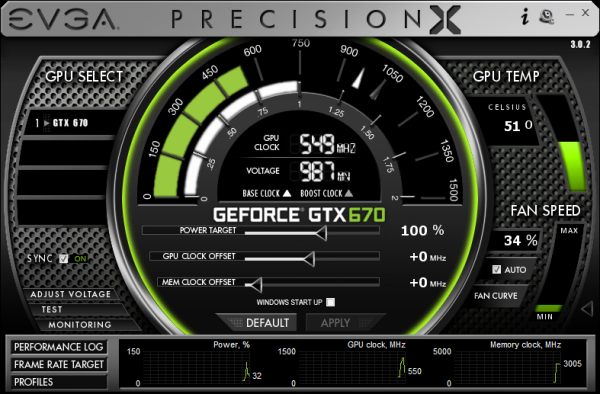NVIDIA GeForce GTX 670 Review Feat. EVGA: Bringing GK104 Down To $400
by Ryan Smith on May 10, 2012 9:00 AM ESTMeet The EVGA GeForce GTX 670 Superclocked
Our second card of the day is EVGA’s GeForce GTX 670 Superclocked, which in EVGA’s hierarchy is their first tier of factory overclocked cards. EVGA is binning GTX 670s and in turn promoting some of them to this tier, which means the GTX 670 Superclocked are equipped with generally better performing chips than the average reference card.
| GeForce GTX 670 Partner Card Specification Comparison | ||||
| EVGA GeForce GTX 670 Superclocked | GeForce GTX 670 (Ref) | |||
| CUDA Cores | 1344 | 1344 | ||
| Texture Units | 112 | 112 | ||
| ROPs | 32 | 32 | ||
| Base Clock | 967MHz | 915MHz | ||
| Boost Clock | 1046MHz | 980MHz | ||
| Memory Clock | 6210MHz | 6008MHz | ||
| Memory Bus Width | 256-bit | 256-bit | ||
| Frame Buffer | 2GB | 2GB | ||
| TDP | 170W | 170W | ||
| Manufacturing Process | TSMC 28nm | TSMC 28nm | ||
| Width | Double Slot | Double Slot | ||
| Length | 9.5" | 9.5" | ||
| Warranty | 3 Years | N/A | ||
| Price Point | $419 | $399 | ||
For the GTX 670 SC, EVGA has given both the core clock and memory clock a moderate boost. The core clock has been increased by 52MHz (6%) to 967MHz base and 66MHz (7%) boost to 1046MHz. Meanwhile the memory clock has been increased by 202MHz (3%) to 6210MHz.
Other than the clockspeed changes, the GTX 670 SC is an almost-reference card utilizing a reference PCB with a slightly modified cooler. EVGA is fabricating their own shroud, but they’ve copied NVIDIA’s reference shroud down to almost the last detail. The only functional difference is that the diameter of the fan intake is about 5mm less, otherwise the only difference is that EVGA has detailed it differently than NVIDIA and used some rounded corners in place of square corners.
The only other change you’ll notice is that EVGA is using their own high flow bracket in place of NVIDIA’s bracket. The high flow bracket cuts away as much metal as possible, maximizing the area of the vents. Though based on our power and temperature readings, this doesn’t seem to have notably impacted the GTX 670 SC.
While we’re on the matter of customized cards and factory overclocks, it’s worth reiterating NVIDIA’s position on factory overclocked cards. Reference and semi-custom cards (that is, cards using the reference PCB) must adhere to NVIDIA’s power target limits. For GTX 670 this is a 141W power target, with a maximum power target of 122% (170W). Fully custom cards with better power delivery circuitry can go higher, but not semi-custom cards. As a result the flexibility in building semi-custom cards comes down to binning. EVGA can bin better chips and use them in cards such as the Superclocked – such as our sample which can go 17 boost bins over the base clock versus 13 bins for our reference GTX 670 – but at the end of the day for stock performance they’re at the mercy of what can be accomplished within 141W/170W.
In any case, as the card is otherwise a reference GTX 670 EVGA is relying on the combination of their factory overclock, their toolset, and their strong reputation for support to carry the card. EVGA has priced the card at $419, $20 over the GTX 670 MSRP, in-line with other factory overclocked cards.
On the subject of pricing and warranties, since this is the first EVGA card we’ve reviewed since April 1st, this is a good time to go over the recent warranty changes EVGA has made.
Starting April 1st, EVGA has implemented what they’re calling their new Global Warranty Policy. Starting July 1st, 2011 (the policy is being backdated), all new EVGA cards ship with at least a 3 year warranty. And for the GTX 600 series specifically, so far EVGA has only offered models with a 3 year warranty in North America, which simplifies their product lineup.
To complement the 3 year warranty and replace the lack of longer term warranties, EVGA is now directly selling 2 and 7 year warranty extensions, for a total of 5 and 10 years respectively. So instead of buying a card with a 3 year warranty or a longer warranty, you’ll simply buy the 3 year card and then buy a warranty extension to go with it. However the extended warranty requires that the card be registered and the warranty purchased within 30 days.
The second change is that the base 3 year warranty no longer requires product registration. EVGA has other ways to entice buyers into registering, but they’ll now honor all applicable cards for 3 years regardless of the registration status. At the same time the base 3 year warranty is now a per-product warranty (e.g. a transferable warranty) rather than per-user warranty, so the base warranty will transfer to 2nd hand buyers. The extended warranties however will not.
The third change is how EVGA is actually going to handle the warranty process. First and foremost, EVGA is now allowing cards to be sent to the nearest EVGA RMA office rather than the office for the region the card was purchased from. For example a buyer moving from Europe to North America can send the card to EVGA’s North American offices rather than sending it overseas.
Finally, EVGA is now doing free cross shipping, alongside their existing Advanced RMA program. EVGA will now cross-ship replacement cards for free to buyers. The buyer meanwhile is responsible for paying to ship the faulty card back and putting up collateral on the new card until EVGA receives the old card.
There’s also one quick change to the step-up program that will impact some customers. With the move to purchasing extended warranties, the step-up program is only available to customers who either purchase an extended warranty or purchase an older generation card that comes with a lifetime warranty. Step-up is not available to cards with only the base 3 year warranty.
Moving on, along with EVGA’s new warranty EVGA is bundling the latest version of their GPU utilities, Precision X and OC Scanner X.
Precision X, as we touched upon quickly in our GTX 680 review, is the latest iteration of EVGA’s Precision overclocking & monitoring utility. It’s still based on RivaTuner and along with adding support for the GTX 600 series features (power targets, framerate caps, etc), it also introduces a new UI. Functionality wise it’s still at the top of the pack along with the similarly RivaTuner powered MSI Afterburner. Personally I’m not a fan of the new UI – circular UIs and sliders aren’t particularly easy to read – but it gets the job done.
OC Scanner X has also received a facelift and functionality upgrade of its own. Along with its basic FurMark-ish stress testing and error checking, it now also offers a basic CPU stress test and GPU benchmark.



















414 Comments
View All Comments
SlyNine - Saturday, May 12, 2012 - link
I'm starting to think you're alittle crazy.CeriseCogburn - Sunday, May 13, 2012 - link
Say it 3 more times ( as you have already), it certainly invalidates all the reasons why the amd card loses badly.Nice, desperate try there. Not.
medi01 - Friday, May 11, 2012 - link
Let me guess: because you can actually get either 680 or 670 at the announced price (if at all), eh?So you can't? And when you will be able to get one, street price would probably be higher than MSRP, eh?
So what are you buzzing about?
CeriseCogburn - Friday, May 11, 2012 - link
Oh that's too bad, you're wrong again. 670 still 399 at the egg.Order, go ahead in STOCK.
How about someone ban you for just being a smart aleck, isn't that what a zealout of no use whatsoever really is ? Are you going to claim this is your joke and rip on others place ? Why didn't you check availability or read about it in the article the reviewer in fact went into quite some detail and extrapolation on the differences between this and the 680 and 690, but you never read the review did you ?
You just come here to attack others and smart off for amd points.
SlyNine - Saturday, May 12, 2012 - link
I got a GTX680 for 499$, but still he needs to chill. If someone bought a 7970 before the 670GTX came out it might have been the fast card they could find for the money.Not counting dual GPU solutions of course ( I hate those).
CeriseCogburn - Sunday, May 13, 2012 - link
I wonder who that someone would be, yours truly.I guess your comprehension skills are not really up to par.
Spunjji - Friday, May 11, 2012 - link
Trololol "viral marketing group". xDHe's just pissed off because he thinks the other side are getting paid for being mindless bigots...
CeriseCogburn - Friday, May 11, 2012 - link
No it's clear none of you are being paid a dime, not even a single housefire amd 7970 woodscrew.CeriseCogburn - Friday, May 11, 2012 - link
This should make the amd fans happy, immense amd bias by the reviewer, again.TWS2
" The GTX 570 and it’s increasingly puny 1.25GB of RAM can’t even run this game with our 2560 benchmark settings "
What the reviewer forgets to mention is that at 2560 and their benchmark settings not a single card present is playable, all under 29 fps and the majority under 20.
ROFL
That might be entirely different without the new game patch bug that affects only nVidia, but the very fact that the reviewer moans about "the 570" "puny ram" problem while noting a COMPLETELY UNPLAYABLE GAME BENCHMARK FROM THE HIGHEST TIERED 3G RAM AMD FLAGSHIP CARD...
Where exactly is the brain ?
This is the kind of crap we have to put up with here, at least we who have a brain and can see what's going on.
I guess the amd fanboys can thank the reviewer for further perpetuation of the ram bottleneck MYTH.
What a JOKE ATTACK on the nVidia card.
Worse yet, on the very next page, the very same GTX570 beats the amd opposition 2G ram 7870 at 2560 but it can't be mentioned.
SlyNine - Saturday, May 12, 2012 - link
lol, the 7970 runs it at 28. Which is playable in a game like that.Funny the 7970 is by far more playable at that res. thanks for pointing that out.
Of course once Nvidia fixes the bug they should rerun the test.